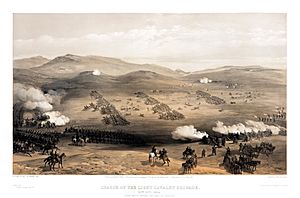4th Queen's Own Hussars facts for kids
Quick facts for kids 4th Queen's Own Hussars |
|
|---|---|
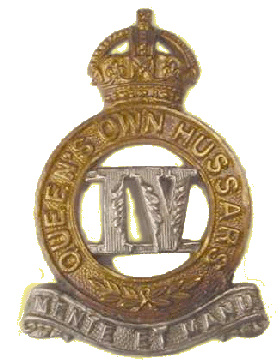
Crest of the 4th Queen's Own Hussars
|
|
| Active | 1685 - 1958 |
| Country | |
| Branch | |
| Type | Cavalry of the Line/Royal Armoured Corps |
| Role | Light Cavalry |
| Size | Regiment |
| Part of | Royal Armoured Corps |
| Regimental Headquarters | London |
| Nickname(s) | Paget's Irregular Horse |
| Motto(s) | Mente et Manu (With Mind and Hand) |
| March | Quick: Berkeley's Dragoons Slow: Litany of Loretto |
| Anniversaries | Salamanca Day, 22 July Balaklava Day, 25 October St Patrick's Day, 17 March |
| Commanders | |
| Colonel-in-Chief | Sir Winston Churchill |
The 4th Queen's Own Hussars was a famous cavalry regiment in the British Army. It was first formed way back in 1685. This regiment served for over 270 years, fighting in major conflicts like the First World War and the Second World War. In 1958, it joined with another regiment, the 8th King's Royal Irish Hussars, to create the Queen's Royal Irish Hussars.
History of the Regiment
Starting Out: Early Years and Battles
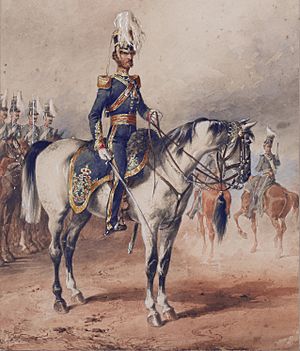
The regiment began in 1685 as "The Princess Anne of Denmark's Regiment of Dragoons." Dragoons were soldiers who could fight on horseback or on foot. They were formed to help stop the Monmouth Rebellion.
The regiment quickly proved itself in battle. They fought in the Nine Years' War, including the tough Battle of Steenkerque in 1692. Later, they faced heavy losses at the Battle of Almansa in 1707 during the War of the Spanish Succession.
In 1743, during the War of the Austrian Succession, a brave soldier named Trooper George Daraugh recovered the regiment's flag after it was taken by a French officer at the Battle of Dettingen. The regiment was officially named the "4th Regiment of Dragoons" in 1751. In 1788, it was renamed the "4th (Queen's Own) Regiment of Dragoons" after Queen Charlotte.
Fighting in Spain and Afghanistan
The regiment played a big part in the Peninsular War in Spain. They fought under Sir Arthur Wellesley, who later became the Duke of Wellington. They helped win battles like Talavera in 1809 and Salamanca in 1812. After Salamanca, they even captured some of the French King Joseph Bonaparte's silver! They also fought at Vitoria and Toulouse.
In 1818, the regiment became "light dragoons," meaning they were faster and more flexible. They then went to fight in the First Anglo-Afghan War, taking part in the Battle of Ghazni in 1839.
The Famous Charge of the Light Brigade
One of the most famous events in the regiment's history was the Charge of the Light Brigade in October 1854. This happened during the Crimean War. The regiment was part of the Light Brigade, led by Major General the Earl of Cardigan.
During the charge, the brigade rode straight into Russian cannons and cavalry. They broke through the enemy lines but had to retreat because they didn't have enough support. It was a very dangerous charge, and the regiment lost many men.
A soldier named Private Samuel Parkes showed incredible bravery during this charge. He saved the life of a Trumpeter, Hugh Crawford, and was awarded the Victoria Cross, the highest award for bravery in the British military.
In 1861, the regiment changed its name again to the "4th (Queen's Own) Hussars." A very famous person, Winston Churchill, joined the 4th Hussars as a young officer in 1895.
World War I: On the Western Front
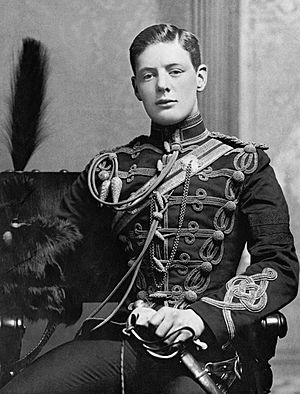
When the First World War started in August 1914, the regiment was sent to France. They fought on the Western Front, which was a long line of trenches.
They were involved in some of the war's earliest and toughest battles, including the Great Retreat and the First Battle of Ypres in 1914. They also fought in the Second Battle of Ypres in 1915. In March 1918, they helped stop a German advance at the Battle of Moreuil Wood, where their commanding officer was killed.
Between the World Wars and New Machines
After the First World War, the regiment was renamed the "4th Queen's Own Hussars" in 1921. They spent some time in India. A big change happened in 1936: the regiment became "mechanized." This meant they stopped using horses and started using tanks and other armored vehicles instead. In 1939, they officially joined the Royal Armoured Corps.
World War II: Battles in Greece and Africa
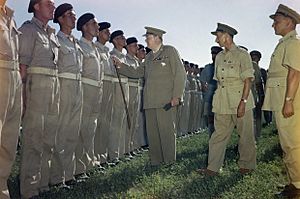
During the Second World War, the regiment was sent to the Middle East in late 1940. They fought in the Greek Campaign. In a tough fight at the Corinth Canal Bridge, they were surrounded and many soldiers became prisoners of war.
The regiment was rebuilt in Cairo in June 1941. They then fought in North Africa, including the difficult Battle of Gazala in May 1942. They lost many men and tanks there. For a short time, they combined with another regiment, the 8th King's Royal Irish Hussars, to form the "4th/8th Hussars." They fought bravely in the Battle of Alam el Halfa and the famous Second Battle of El Alamein in 1942.
Later, the regiment played an important role in the Italian campaign, helping the Allies push into enemy territory. Winston Churchill, who had been a young officer in the regiment, became its Honorary Colonel in 1941.
After the War: A New Beginning
After the Second World War, the 4th Hussars were stationed in Germany and then in Malaya in Southeast Asia. They returned to the UK in 1951.
In 1958, the regiment officially joined with the 8th King's Royal Irish Hussars to form a new regiment called the Queen's Royal Irish Hussars. This marked the end of the 4th Queen's Own Hussars as a separate unit.
Regimental Museum
You can learn more about the regiment's history at its museum in Warwick, called "Trinity Mews." It opened in April 2022.
Brave Actions and Awards
The regiment earned many "Battle Honours" for its bravery in different wars. These are special names given to regiments to mark their important victories and actions.
- Early Wars: Dettingen, Talavera, Salamanca, Balaklava, Sevastopol
- The Great War: Mons, Ypres 1914 '15, Arras 1917, Cambrai 1917, Somme 1918, France and Flanders 1914-18
- The Second World War: Gazala, El Alamein, North Africa 1942, Italy 1944-45, Greece 1941
Victoria Cross Winner
- Private Samuel Parkes received the Victoria Cross during the Crimean War on 25 October 1854.
See also


